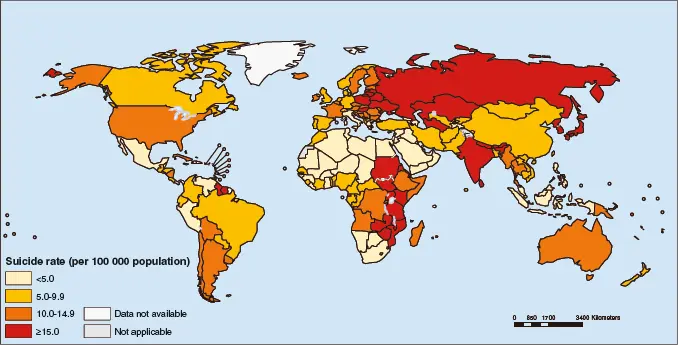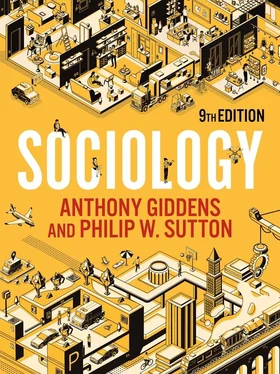Nonetheless, Durkheim thought that social change in the modern world was so rapid and intense that major difficulties could arise. As societies change, so do lifestyles, morals, beliefs and accepted patterns of behaviour. But, when change is rapid and continuous, the old values lose their grip on people without any new ones becoming established. Durkheim called such an unsettling condition anomie – deep feelings of aimlessness, dread and despair, as many people are left perceiving that their lives lack meaning and structure without clear guidelines for action. The big question is whether people can ever get used to continuous rapid change as the ‘normal’ condition of living in conditions of modernity.
Classic studies 1.1 Emile Durkheim’s study of suicide
The research problem
One of the more emotionally unsettling aspects of our lives is the phenomenon of suicide, which often leaves those left behind with more questions than answers. Why do some people decide to take their own lives? Where do the pressures they experience actually come from? One of the early sociological classics which explores the relationship between the individual and society is Emile Durkheim’s analysis of suicide rates, Suicide: A Study in Sociology (Durkheim 1952 [1897]). Even though people see themselves as individuals exercising free will and choice, Durkheim’s study showed that even a highly personal act such as suicide is influenced by what happens in the wider social world.
Research had been conducted on suicide before Durkheim’s study, but he was the first to insist on a sociological explanation. Previous writers had acknowledged the influence of ‘racial type’, climate or mental disorder to explain an individual’s likelihood of committing suicide. But Durkheim argued that the suicide rate – the percentage of suicides per 100,000 of the population – was a social fact that could only be explained by other social facts and that suicide rates vary widely across the world’s societies (see figure 1.1).
By examining official statistics in France, Durkheim found that certain social groups were more likely to commit suicide than others. He discovered that more men committed suicide than women, more Protestants than Catholics, the wealthy more than the poor, and single people more than those who were married. The question was, why?
These findings led Durkheim to conclude that there are social forces external to the individual which influence suicide rates. He related his explanation to the idea of social solidarity and to two types of bonds within society – social integration and social regulation. Durkheim argued that people who were strongly integrated into social groups, and whose desires and aspirations were regulated by social norms, were less likely to commit suicide. From this he deduced four types of suicide, in accordance with the relative presence or absence of integration and regulation.
1 Egoistic suicides are marked by low integration and occur when an individual becomes isolated or when their ties to a social group are weakened or broken. For example, the low rates of suicide among Catholics could be explained by their strong community, while the personal and moral freedom of Protestants meant that they ‘stand alone’ before God. Marriage protects against suicide by integrating the individual into a stable social relationship, while single people remain more isolated.
2 Anomic suicide is caused by a lack of social regulation. By this, Durkheim referred to the condition of anomie, when people are rendered ‘normless’ as a result of rapid change or economic instability. The loss of a fixed point of reference for norms and desires – such as in times of economic upheaval or in personal troubles such as divorce – can upset the balance between people’s circumstances and their desires such that they no longer know how to carry on.
3 Altruistic suicide occurs when an individual is ‘over-integrated’ – social bonds are too strong – and comes to value the group more than him- or herself. In such a case, suicide becomes a sacrifice for the ‘greater good’. Japanese kamikaze pilots or Islamist suicide bombers are examples. Durkheim saw these as more common in traditional societies where mechanical solidarity prevails.
4 The final type is fatalistic suicide. Although Durkheim saw this as of little contemporary relevance, it occurs when an individual is overregulated by society. The oppression of the individual in dictatorial regimes can result in feelings of powerlessness and hopelessness.

Figure 1.1 Age-standardized suicide rates, both sexes, 2016
Source : WHO (2018a).
Suicide rates vary across societies but are also quite stable within particular societies over time. Durkheim took this as evidence that there are consistent social forces that influence suicide rates, and therefore we can see that general social patterns can be detected even within individual actions.
Since its publication, many objections have been raised to Durkheim’s study, particularly in relation to his uncritical use of official statistics, his dismissal of non-social influences and his insistence in classifying all types of suicide together. Some critics have shown that it is vitally important to understand the social process involved in collecting data on suicides, as coroners’ definitions and criteria influence the number of deaths that are recorded as ‘suicides’ in the first place. Because of this, suicide statistics may be highly variable across societies, as Durkheim suggests, but this is not necessarily because of differences in suicidal behaviour; rather, it is due to divergent practices adopted by coroners in recording ‘unexplained deaths’. Suicide statistics may not give us a valid or reliable picture of the extent of suicide in a given society.
Contemporary significance
The arguments of his critics are legitimate, yet Durkheim’s study remains a sociological classic. It helped to establish sociology as a discipline with its own subject – the study of social facts – and his fundamental argument retains much of its force: that to grasp fully even the most personal actions of individuals demands a sociological explanation rather than one rooted in the exploration of personal motivation. Durkheim’s identification of suicide rates as a subject for study is today widely accepted, and the study is also important for its demonstration that social phenomena are amenable to systematic, scientific analysis using a rigorous methodology.
Monitor your local news for three reports of possible suicide cases. From the information provided, are any of the details presented as factors that would contribute to explaining the death as a ‘suicide’? Why might coroners lean away from a suicide verdict, and would that practice affect Durkheim’s argument that there are suicide rates in particular societies? Should we accept the WHO statistics in figure 1.1 above as ‘social facts’?
The ideas of Karl Marx (1818–83) contrast sharply with those of Comte and Durkheim, though he too sought to explain the changes associated with the Industrial Revolution. As a young man, Marx found that his political activities brought him into conflict with the German authorities, and after a brief stay in France he settled permanently in exile in Britain, where he saw the growth of factories and industrial production as well as growing inequality. His interest in the European labour movement and socialist ideas was reflected in his writings, and much of his work concentrated on political and economic issues. Yet, since he connected economic problems to social institutions, his work was rich in sociological insights.
Читать дальше













